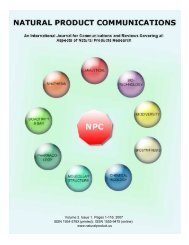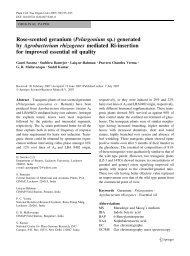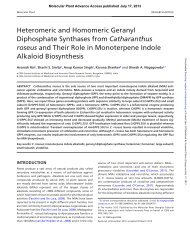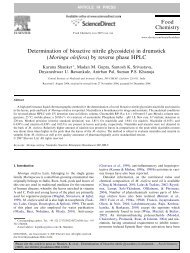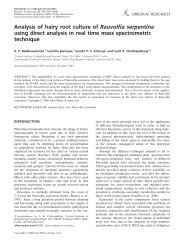Birendra Kumar*, SK Verma, G Ram,HP Singh. 2012 ... - CIMAP Staff
Birendra Kumar*, SK Verma, G Ram,HP Singh. 2012 ... - CIMAP Staff
Birendra Kumar*, SK Verma, G Ram,HP Singh. 2012 ... - CIMAP Staff
- No tags were found...
You also want an ePaper? Increase the reach of your titles
YUMPU automatically turns print PDFs into web optimized ePapers that Google loves.
Journal of Crop Improvement, 26:791–801, <strong>2012</strong><br />
Copyright © Taylor & Francis Group, LLC<br />
ISSN: 1542-7528 print/1542-7536 online<br />
DOI: 10.1080/15427528.<strong>2012</strong>.689799<br />
Temperature Relations for Seed Germination<br />
Potential and Seedling Vigor in Palmarosa<br />
(Cymbopogon martinii)<br />
BIRENDRA KUMAR, S. K. VERMA, GOVIND RAM, and H. P. SINGH<br />
Seed Quality Lab, Genetics & Plant Breeding Division, Central Institute of Medicinal<br />
and Aromatic Plants (CSIR), Lucknow, India<br />
Downloaded by [<strong>Birendra</strong> Kumar] at 06:15 20 November <strong>2012</strong><br />
Because of non-synchronous flowering, fruiting, and dispersal of<br />
seeds, production and supply of quality seeds with well-defined<br />
germination potential parameters in Palmarosa are important<br />
issues for the growers. The objective of this study was to determine<br />
seed germination potential and seedling vigor of Palmarosa varieties<br />
under four temperature regimes at daily 16 h light/8 hdark<br />
regimes. At 25 ◦ C, germination percentage was highest for variety<br />
PRC-1 (67.8%), followed by varieties Tripta (59.3%), Trishna<br />
(57.5%), and Vaishnavi (35.5%). The mean for seedling vigor<br />
index I was highest for Trishna (277.7), followed by Tripta (259.3),<br />
PRC-1 (256.2), and Vaishnavi (140.4). However, vigor index II<br />
mean was highest for Tripta (0.2826), followed by PRC-1 (0.2615),<br />
Trishna (0.2600), and Vaishnavi (0.1388). Regardless of variety<br />
ranking by vigor index I vs. index II, the highest seedling vigor for<br />
all varieties was at 25 ◦ C using either index. However, since mass<br />
is a better indicator of seedling growth/health than length, vigor<br />
index II (based on mass) would give a better indication of early<br />
seedling vigor than index I (based on length). The low germination<br />
percentage and vigor of Vaishnavi is attributable to the genetic<br />
Received 7 March <strong>2012</strong>; accepted 26 April <strong>2012</strong>.<br />
Authors are indebted to Prof. (Dr.) <strong>Ram</strong> Rajasekharan, director, CSIR-Central Institute of<br />
Medicinal and Aromatic Plants (CSIR), Lucknow, India, for experimentation facilities; Prof.<br />
(Dr.) Carol C. Baskin, Department of Plant and Soil Sciences, University of Kentucky, United<br />
States; Prof. (Dr.) Manjit S. Kang, editor-in-chief; and two anonymous reviewers for their<br />
critical suggestions on upgrading the manuscript. Financial assistance of Uttar Pradesh Council<br />
of Science and Technology, Lucknow, India, is also acknowledged.<br />
Address correspondence to <strong>Birendra</strong> Kumar, Seed Quality Lab, Genetics & Plant Breeding<br />
Division, Central Institute of Medicinal and Aromatic Plants (CSIR), P.O. <strong>CIMAP</strong>, Lucknow<br />
226015, India. E-mail: birendrak67@rediffmail.com or b.kumar@cimap.res.in<br />
791




